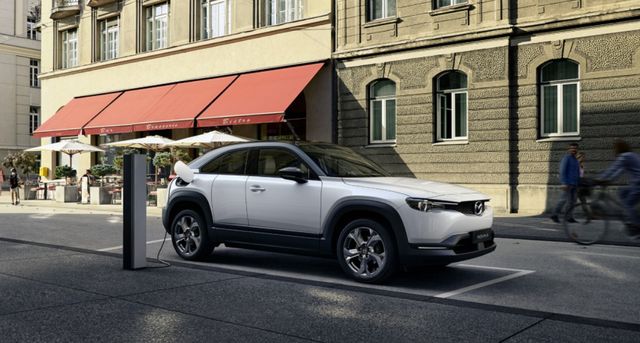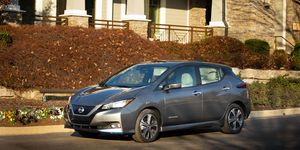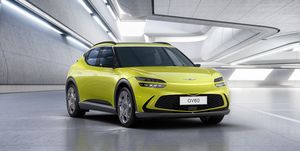This week Mazda published the pricing for its first battery-electric model to be offered stateside—just in California, to be precise—with the MX-30 due to arrive on dealership shelves in October. Set to start at $34,645 before any federal or local incentives, the MX-30 will be powered by a single 143-hp electric motor sending power to the front wheels, drawing juice from a 35.5-kWh battery. With a battery this small, the MX-30 is estimated to offer about 100 miles of range in the EPA cycle, with official figures due in the coming weeks.
Two trim levels will be on the menu for California buyers, the Premium Plus flavor coming with a Bose 12-speaker premium audio system, 360-degree view monitor with front parking sensors, keyless entry, heated steering, and an all-new i-Activsense safety suite that includes front cross traffic alert and blind spot monitoring. This package will start at $37,655. The base version, meanwhile, will offer enough comfort features itself, including an 8.8-inch center display, leather-wrapped steering wheel and shift knob, heated front seats, a 7-inch digital gauge cluster, 18-inch silver finish aluminum alloy wheels, and heated front seats, among other standard features.4
The MX-30 will perhaps be more coupe-like than other coupe-shaped electric crossovers, offering RX-8-style rear half doors and more compact dimensions than most of its crossover competitors, splitting the difference between electric hatchbacks and compact crossovers, which are growing in number.
Among other things, the MX-30 raises the question of precisely what type of EV buyer it’s for, and what their residual values could be in two or three years. Certainly, it won’t be lost on buyers in California that there are cheaper ways to get into an EV with this range, if 100 miles of range is all they need.
A range of 100 miles and a price of $34,645 would have resonated 10 years ago, when the Nissan Leaf was just about the only game in town when it came to lower-priced EVs. For 2022, the competition has moved far beyond this range. The Leaf received a price cut earlier this summer ahead of the arrival of the Nissan Ariya, and in base form offers a 149-mile range—already a big percentage bump over the MX-30—while the longer-range trims offers up to 226 miles of range. The Chevy Bolt, on the other hand, currently offers a 259-mile range, while still undercutting the MX-30 in price with a starting price of $31,995.
The Mini Cooper SE is just about the only major EV at the moment with a comparable range, weighing in at 110 miles.
Its California-only availability may not help the MX-30 all that much, as even with its incentives and demand the California EV market is much more EV-savvy when it comes to shoppers’ expectations of range and price, not to mention a greater availability of used EVs. Just how well the MX-30 will compete against EVs half a decade old remains to be seen.
To offset this range, the automaker will offer MX-30 buyers what it calls the Mazda MX-30 Elite Access Loaner Program, permitting owners to use other Mazdas for up to 10 days per year for the first three years of ownership.
It is worth noting that Honda had also experimented with a lower-range EV in the recent past, offering the Clarity Electric in California and Oregon starting in 2017 with a range of 89 miles, which by that point in time was already painfully dated. The automaker pulled the car from both states in the spring of 2020 and does not currently offer an EV, and pulled its hydrogen fuel-cell twin in June of this year.
Source: Read Full Article





